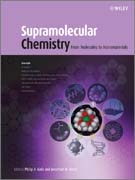
Supramolecular chemistry: from molecules to nanomaterials
Steed, Jonathan W.
Gale, Philip A.
Supramolecular Chemistry: From Molecules to Nanomaterials is a new major reference work which links supramolecular chemistry and nanomaterials. Presenting over 160 tutorial articles and spanning over 10 comprehensive sections, this new resource covers: Concepts Techniques Molecular recognition Supramolecular reactivity Supramolecular aspects of chemical biology Self processes Supramolecular devices Supramolecular materials chemistry Soft matter Nanotechnology Supramolecular chemistry is 'chemistry beyond the molecule'. While traditional chemistry focuses on the bonds that hold atoms together in a molecule, supramolecular chemistry examines the weaker interactions that hold groups of moleculestogether. Important concepts that have been demonstrated by supramolecular chemistry include molecular self-assembly, folding, molecular recognition, host-guest chemistry, mechanically-interlocked molecular architectures, and dynamiccovalent chemistry. The importance of supramolecular chemistry was established by the 1987 Nobel Prize for Chemistry, which was awarded to Donald J. Cram, Jean-Marie Lehn, and Charles J. Pedersen in recognition of their work in the field. The past decade has seen dramatic developments in the field, with supramolecular chemistry leaving its roots in classical host guest chemistry and expanding into exciting areas of materials chemistry and nanoscience with many real and potential applications. Supramolecular findings are evolving our understanding of the way chemical concepts at the molecular level build up into materials and systems with fascinating, emergent properties on the nanoscale. Supramolecular chemistry: the biggest challenge yet! 'Creating that link between the chemist's understanding of the way in which molecules interact with one another, and the understanding a materials scientist, engineer or biologist has of the resulting properties of a material or system comprised of those molecules is one of the huge grand challenges facing modern molecular science.' Philip A. Gale and Jonathan W. Steed, Editors-in-Chief Linking supramolecular chemistry and nanotechnology to define the field in the 21st Century SupramolecularChemistry: From Molecules to Nanomaterials is the first major reference to link supramolecular chemistry and nanotechnology. A global team of experts present an overview of the concepts and techniques of modern supramolecular chemistry, demonstrating how these paradigms evolve into nanoscale systems chemistry,nanotechnology, materials science and beyond. Breaking down the barriers between synthetic chemistry and materials science, the authors demonstrate how modern techniques allow access increasingly far along the 'synthesising-up' pathway. Supramolecular Chemistry: From Molecules to Nanomaterials explains the fundamental concepts and provides invaluable practical guidance on the applications and limitations of modern instrumental techniques for addressi INDICE: Section 1: Concepts (Philip Gale, University of Southampton, UK & Eric Anslyn, University of Texas at Austin, USA). Section 2: Techniques (Bradley Smith, University of Notre Dame, USA and Edwin Constable, University of Basel, Switzerland). Section 3: Molecular Recognition (Enrique García-España, Universidad de Valencia, Spain). Section 4: Supramolecular Reactivity (Douglas Philp, University of St Andrews, UK). Section 5: Supramolecular Aspects of Chemical Biology (Section Editor: Marcey Waters, University of North Carolina, USA). Section 6: Self-Processes (David Amabilino, , Institut de Ciencia de Materials de Barcelona (CSIC), Spain). Section 7: Supramolecular Devices (Pavel Anzenbacher, Bowling Green State University, USA). Section 8: Supramolecular Materials Chemistry (Len Barbour, University of Stellenbosch, South Africa). Section9: Soft Matter (David K Smith, University of York, UK). Section 10: Nanotechnology (Paula Mendes & Jonathan Preece, University of Birmingham, UK).
- ISBN: 978-0-470-74640-0
- Editorial: John Wiley & Sons
- Encuadernacion: Cartoné
- Páginas: 4680
- Fecha Publicación: 27/01/2012
- Nº Volúmenes: 8
- Idioma: Inglés
